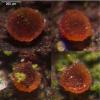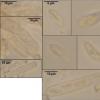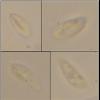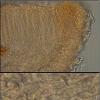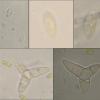
30-12-2025 16:44
Pascal DucosBonjour,Une anamorphe rose stipitée, très nombre

30-12-2025 17:14
 Bernard CLESSE
Bernard CLESSE
Bonjour à toutes et tous,Pourriez-vous aider Albe

29-12-2025 10:15
Hulda Caroline HolteHello, I found and collected this propoloid ascom

30-12-2025 09:04
Hello.A Pyrenomycete sprouting sparsely but very d

29-12-2025 17:44
Isabelle CharissouBonjour,J'aimerais savoir si d'autres personnes au

12-11-2021 00:03
Lepista ZacariasHi everybody,A week ago in my fiels trip I noticed

29-12-2025 17:12
 Bernard CLESSE
Bernard CLESSE
Bonjour à toutes et tous,Pourriez-vous m'aider à
Orbilia spec. 1
Gernot Friebes,
29-11-2009 12:48
I found these two Orbilia on a dead, still attached branch of Rosa, ca. 150 cm above the ground.
The first species (the one I show here) has spores of 6-8(9) x 2-3 µm with straight SB which fill 1/2 to 2/3 of the spores. The asci are 8-spored and the paraphses often septate (they look somehow chain-like).
Thanks in advance your help!
Best wishes,
Gernot
Jean-Paul Priou,
29-11-2009 14:02

Re:Orbilia spec. 1
cela devrait aller vers gambelli
jPP
jPP
Hans-Otto Baral,
29-11-2009 15:31

Re:Orbilia spec. 1
Another possibility would be O. trapeziformis. O. gambelii has usually ellipsoid spores and trapeziformis trapezoid, but sometimes the difference is not as clear. A distinct difference is in the SCBs. Could you please make a median section and look in the living excipular cells on flanks and margin? O. gambelii has there rather conspicuous SCBs (angular, usually pale orange) which trapeziformis never has.
O. gambelii is a (sub)mediterranean species. But O. trapeziformis I so far never had on Rosa.
Perhaps you could make more spore photos: Is there sometimes a short tail or at least a more tapered spore base?
Zotto
O. gambelii is a (sub)mediterranean species. But O. trapeziformis I so far never had on Rosa.
Perhaps you could make more spore photos: Is there sometimes a short tail or at least a more tapered spore base?
Zotto
Gernot Friebes,
29-11-2009 18:16
Re:Orbilia spec. 1
Hi,
well, now I know that Orbilia is a really mean genus. I wanted to make a section of an apothecium and suddenly there were different spores - there is a third species on the substrate. I'll show it as Orbilia spec. 3.
Now to O. trapeziformis/gambelii. I think it is trapeziformis because of the form of the spores (there were some with a tail which I, however, could not photograph because they always swam away) and because there weren't any SCBs in the excipular cells.
Best wishes,
Gernot
well, now I know that Orbilia is a really mean genus. I wanted to make a section of an apothecium and suddenly there were different spores - there is a third species on the substrate. I'll show it as Orbilia spec. 3.
Now to O. trapeziformis/gambelii. I think it is trapeziformis because of the form of the spores (there were some with a tail which I, however, could not photograph because they always swam away) and because there weren't any SCBs in the excipular cells.
Best wishes,
Gernot
Hans-Otto Baral,
29-11-2009 20:37

Re:Orbilia spec. 1
Splendid! These star-shaped Trinacrium-conidia belong to Orbilia, and well possibly to this trapeziformis, but they could belong also to another one, though surely not to clavuliformis and septispora. Who knows how many you will further detect :-)
Zotto
Zotto



